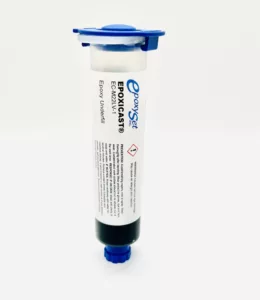OEMs face ever-growing requirements for greater chip functionality, reduced size, mechanical toughness, and high reliability. As market trends that drive greater functionality, reliability, and ruggedness, the consumer demand for handheld, mobile, and portable systems, such as smart phones and tablets increase daily.
Ball Grid Array (BGA) and chip scale packaging (CSP) are common solutions for many of these problems however; other problems arise in using these techniques. Common processing problems include extremely short solder joints and thermal stress release.
Underfill for CSP and BGA
An underfill is a polymer applied on the PCB after it has been subjected to reflow. Underfills are typically epoxies however urethanes are also used. Underfills encapsulate the bottom side of the silicone chip protecting the fragile connections made from the bottom of the silicone chip and top of the PCB. Using underfills on BGAs and CSP produces enhanced mechanical and thermal properties.
Underfills are typically dispensed on the corners or around the edge of the BGA/SCP which are then (on the PCB) heated so the underfill can absorb to under the chip. Typically it is heated to 120-165°C. The temperature remains until the polymer is completely cured. The whole process takes anywhere from 5 minutes to over an hour depending on the polymer. More resilient underfills can take longer to cure and to reduce shrinkage during cure.
Underfill polymers are becoming more and more popular because it solves many problems associated with smaller form factors. It provides extra rigidity with strong mechanical bonding between chip and the PCB’s corresponding connection, thus protecting solder joints from mechanical stress. Thermally conductive epoxy used as underfills help transfer heat away from highly complex, high power chips. Many low expansion underfills have very low coefficients of thermal expansion (CTE) and can help smaller packaging during thermal cycling. Also, instead of stress only on the roots of the solder balls undefills allow for stress relief across the whole package. Underfill also greatly improves the high-gravitational acceleration (High-G) performance, thermal-cycle performance, and fatigue cycle performance.
Certain harsh environmental forces may deal a particular blow to a device’s solder bonds, damaging solder connections. This is especially true when using a combination of micro-BGAs and micro-CSPs and high reliability requirements. Using undefill epoxy the strength of the connections can multiply 10 fold. The underfill process dramatically enhances thermal-cycling performance and shock resistance of those chip packaging and board connections.
The PCB designers and assembly engineers work together closely to determine the right undefill, amount, and properties are used. Many times, the CTE is the most important property when evaluating underfill systems. Many highly filled epoxy underfill products have a CTE of below 30ppm/°C below glass transition temperature (Tg). These same systems have a Tg of above 120°C and as high as 160°C. Epoxyset’s EC-M22LV-1 is an example of a highly filled, rigid epoxy undefill.
Another type of underfill are low modulus underfill systems. These tend to be high CTE and lower Tg however the lower modulus allows the better absorption of mismatch between the board and chip. Low modulus underfill systems generally tend to be flexible urethane or epoxy systems. EPOXIBOND EB-109M-4 is an unfilled, low modulus undefill that has excellent capillary action for easy application. A urethane option is UB-55 or UB-70. These 2 products are low modulus and use sustainable raw materials.



